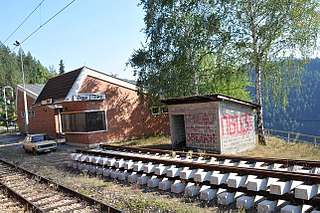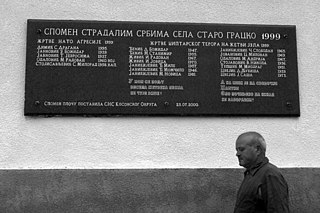This article needs to be updated.(May 2023) |
This is a list of massacres in Yugoslavia during the 20th century.
This article needs to be updated.(May 2023) |
This is a list of massacres in Yugoslavia during the 20th century.


The Zagreb rocket attacks was one of the many massacres in Croatia.

Main article: List of massacres in the aftermath of the Kosovo War
The Račak massacre or Račak operation was the massacre of 45 Kosovo Albanians that took place in the village of Račak in central Kosovo in January 1999. The massacre was perpetrated by Serbian security forces in response to Albanian separatist activity in the region. The Serbian government refused to let a war crimes prosecutor visit the site, and maintained that the casualties were all members of the rebel Kosovo Liberation Army (KLA) killed in combat with state security forces.

The Washington Agreement was a ceasefire agreement between the Republic of Bosnia and Herzegovina and the Croatian Republic of Herzeg-Bosnia, signed on 18 March 1994 in Washington, D.C. It was signed by Bosnian Prime Minister Haris Silajdžić, Croatian Foreign Minister Mate Granić and President of Herzeg-Bosnia Krešimir Zubak.
The Vukovar massacre, also known as the Vukovar hospital massacre or the Ovčara massacre, was the killing of Croatian prisoners of war and civilians by Serb paramilitaries, to whom they had been turned over by the Yugoslav People's Army (JNA), at the Ovčara farm southeast of Vukovar on 20 November 1991, during the Croatian War of Independence. The massacre occurred shortly after Vukovar's capture by the JNA, Territorial Defence (TO), and paramilitaries from neighbouring Serbia. It was the largest massacre of the Croatian War of Independence.

World War II in the Kingdom of Yugoslavia began on 6 April 1941, when the country was invaded and swiftly conquered by Axis forces and partitioned among Germany, Italy, Hungary, Bulgaria and their client regimes. Shortly after Germany attacked the USSR on 22 June 1941, the communist-led republican Yugoslav Partisans, on orders from Moscow, launched a guerrilla liberation war fighting against the Axis forces and their locally established puppet regimes, including the Axis-allied Independent State of Croatia (NDH) and the Government of National Salvation in the German-occupied territory of Serbia. This was dubbed the National Liberation War and Socialist Revolution in post-war Yugoslav communist historiography. Simultaneously, a multi-side civil war was waged between the Yugoslav communist Partisans, the Serbian royalist Chetniks, the Axis-allied Croatian Ustaše and Home Guard, Serbian Volunteer Corps and State Guard, Slovene Home Guard, as well as Nazi-allied Russian Protective Corps troops.

The Izbica massacre was one of the largest massacres of the Kosovo War. Following the war, the International Criminal Tribunal for the former Yugoslavia (ICTY) found that the massacre resulted in the deaths of about 93 Kosovar Albanians, mostly male non-combatant civilians between the ages of 60 and 70.

The Glina massacres were killings of Serb peasants in the town of Glina in the Independent State of Croatia (NDH) that occurred between May and August 1941, during World War II. The first wave of massacres in the town began on 11 or 12 May 1941, when a band of Ustaše led by Mirko Puk murdered a group of Serb men and boys in a Serbian Orthodox church before setting it on fire. The following day, approximately 100 Serb males were murdered by the Ustaše in the nearby village of Prekopi. Estimates of the overall number of Serbs killed from 11 to 13 May range from 260 to 417. Further killings in Glina occurred between 30 July and 3 August of that same year, when 700–2,000 Serbs were massacred by a group of Ustaše led by Vjekoslav Luburić.

Numerous war crimes were committed by all sides during the Kosovo War, which lasted from 28 February 1998 until 11 June 1999. According to Human Rights Watch, the vast majority of abuses were attributable to the government of Slobodan Milošević, mainly perpetrated by the Serbian police, the Yugoslav army, and Serb paramilitary units. During the war, regime forces killed between 7,000–9,000 Kosovar Albanians, engaged in countless acts of rape, destroyed entire villages, and displaced nearly one million people. The Kosovo Liberation Army has also been implicated in atrocities, such as kidnappings and summary executions of civilians. Moreover, the NATO bombing campaign has been harshly criticized by human rights organizations and the Serbian government for causing roughly 500 civilian casualties.

The Štrpci massacre was the massacre of 19 civilians on 27 February 1993, taken from a Belgrade-Bar train at Štrpci railway station near Višegrad, on Bosnian territory.

United Nations Security Council resolution 1203, adopted on 24 October 1998, after recalling resolutions 1160 (1998) and 1199 (1998) on Kosovo, the Council demanded that the Federal Republic of Yugoslavia comply with previous Security Council resolutions and co-operate with the NATO and Organization for Security and Co-operation in Europe (OSCE) verification missions in Kosovo.

The Croatian War of Independence was fought from 1991 to 1995 between Croat forces loyal to the government of Croatia—which had declared independence from the Socialist Federal Republic of Yugoslavia (SFRY)—and the Serb-controlled Yugoslav People's Army (JNA) and local Serb forces, with the JNA ending its combat operations in Croatia by 1992.
The Bela Crkva massacre was the mass-killing of Kosovo Albanian villagers from Bellacërkë, Kosovo by Yugoslav armed forces on 24–25 March 1999. Twelve hours after NATO had started bombing strategic Yugoslav targets, Yugoslav armed forces came to the area around Bela Crkva, fired artillery, and set fire to the village.
The Varivode massacre was a mass killing that occurred on 28 September 1995 in the village of Varivode, Croatia during the Croatian War of Independence. According to United Nations officials, soldiers of the Croatian Army (HV) and Croatian police killed nine Serb villagers, all of whom were between the ages of 60 and 85. After the war, six former Croatian soldiers were tried for committing crimes in the village, but were all eventually released due to lack of evidence. In 2012, the Supreme Court of Croatia ruled that the Republic of Croatia was responsible for the killings, dubbing the massacre an "act of terrorism," and the following year the municipal court in Knin announced that the Government of Croatia must provide compensation to the children of a couple who were murdered.
The Glogova massacre was the mass murder of 64 Bosniak civilians by Serb forces, consisting of the Yugoslav People's Army (JNA), Bratunac Territorial Defence (TO), local police, and paramilitaries from Serbia, on 9 May 1992. Miroslav Deronjić, the head of the "Bratunac Municipal Board" established by the Serbian Democratic Party (SDS), was sentenced to 10 years in prison by the International Criminal Tribunal for the former Yugoslavia for ordering the massacre.

The Staro Gracko massacre was the mass killing of 14 Kosovo Serb farmers in the village of Staro Gracko in the Kosovo municipality of Lipjan on 23 July 1999. The killings occurred after Yugoslav troops withdrew from the region in the aftermath of the Kosovo War. The massacre is the worst single crime in Kosovo since the conflict ended in June 1999. As of 2019 the perpetrators of the killings have never been found and held accountable.
The Paulin Dvor massacre was an act of mass murder committed by soldiers of the Croatian Army (HV) in the village of Paulin Dvor, near the town of Osijek on 11 December 1991 during the Croatian War of Independence. Of the nineteen victims, eighteen were ethnic Serbs, and one was a Hungarian national. The ages of the victims, eight women and eleven men, ranged from 41 to 85. Two former Croatian soldiers were convicted for their role in the killings and were sentenced to 15 and 11 years, respectively. In November 2010, Croatian President Ivo Josipović laid a wreath at the graveyard of the massacre victims and officially apologized for the killings.
The Ivanci massacre was the complete destruction of the Serb village of Ivanci in eastern Croatia on 30 November 1943 by Nazi German forces.